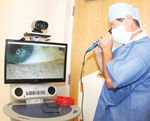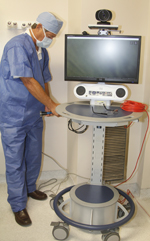|
by Cindy
Abole
Public Relations
One could literally hear a pin
drop in the room where seven
visiting Japanese urologists sat
around a conference table and
stared at the dual video
conference screen in front of
them. Their eyes were focused on
the real-time images from a
prostate brachytherapy procedure
that was taking place across the
street in Rutledge Tower's
outpatient operating room.
The procedure
paired a successful treatment
approach with telemedicine and
emerging technologies. It featured
the campus' video conferencing
system to engage specialists in
the role of medical education
using a dedicated, high-speed
fiber-optic connection. More
specifically, the effort allowed
urologist Harry S. Clarke Jr.,
M.D., Ph.D., radiation oncologist
David T. Marshall, M.D., and a
multidisciplinary team to
demonstrate a real-time ultrasound
image-guided radioactive seed
implantation technique that's
being used for patients diagnosed
with prostate cancer. The two-way
video link-up was established to
provide an interactive learning
opportunity for these visiting
physicians.
 Network engineer
Jonathan Yantis adjusts the
audio during the May 17 prostate
brachytherapy procedure and
video linkup as part of an
interactive learning opportunity
with visiting urologists. Watch
the video at http://bit.ly/Cisco_Cart Network engineer
Jonathan Yantis adjusts the
audio during the May 17 prostate
brachytherapy procedure and
video linkup as part of an
interactive learning opportunity
with visiting urologists. Watch
the video at http://bit.ly/Cisco_Cart
The project was
made possible through the
collaboration of the Department of
Urology, the MUSC Office of the
Chief Information Officer and the
Palmetto State Providers Network
(PSPN). It demonstrated the use of
Cisco TelePresence Solutions' new
high definition VX Clinical
Assistant cart. According to Frank
Clark, Ph.D., chief information
officer and vice president for
information technology, this
project allows physicians and
experts to consult with each other
to diagnose and deliver
high-quality health care to
patients.
This spring,
MUSC was the first hospital in the
country to receive and use Cisco's
cart prior to its May 1 commercial
release.
OCIO's
George Haschker, network systems
team lead, tests the camera on
the Cisco VX Clinical Assistant
cart. The cart allows medical
teams to conduct patient
consultations and video
conferencing.
"This is a very
good example of changing what's
possible in medicine at MUSC
Health using advanced telepresence
and telemedicine technologies.
MUSC Health has established itself
as the telemedicine leader in the
region," said Clark, who also is
PSPN project coordinator.
In 2008, an $8
million grant from the Federal
Communications Commission through
the Rural Health Care Pilot
Program was awarded to MUSC to
develop PSPN and establish a
broadband network linking all 46
counties in South Carolina. The
goal was to provide an
infrastructure for coordinating
telemedicine and telehealth
activities across the state. It
connects rural care providers such
as community hospitals, and
physician practices to the state's
academic and tertiary care medical
centers. The network allows users
to connect for clinical services,
specialty consultations, training
and education.
PSPN and OCIO
have supported other campuswide
web-based telemedicine projects.
These projects include the acute
stroke program; a high-risk
pregnancy telemedicine
consultation program featuring
physicians and OB-GYN specialists.
It also supports connectivity for
SC Area Health Education
Consortium's program office with
regional centers and 20 hospitals.
The surgical
video procedure was coordinated by
Clarke and OCIO staff to
accommodate the visiting
urologists who wanted to watch the
operation.
 The Cisco
TelePresence VX Clinical
Assistant cart is lightweight,
portable and features a 24-inch
1080p video HD LED backlit
display, microphone and stereo
speaker system, 12x HD camera,
slip-proof antibacterial work
surface and software. The Cisco
TelePresence VX Clinical
Assistant cart is lightweight,
portable and features a 24-inch
1080p video HD LED backlit
display, microphone and stereo
speaker system, 12x HD camera,
slip-proof antibacterial work
surface and software.
According to
Clarke, the brachytherapy
procedure usually requires a large
team of specialists present in the
OR. This may include the patient's
urologist, a radiation oncologist,
residents, radiological physicist,
anesthesiologist, technicians, a
manufacturer representative,
assistants and nurses, which makes
it challenging to accommodate
observers.
A test run of
the procedure featuring the VX
cart and related technology was
successfully performed in April.
Using the video conferencing
system, observers also were able
to review equipment and ask
questions. The group's presence
coincided with plans to attend the
American Urology Association
Annual Meeting, May 19-23 in
Atlanta.
"By having this
system in place, we can allow a
large group of colleagues to view
a procedure in real-time while not
being present in the OR. It frees
us from the extra steps that are
necessary to accommodate medical
observers. These outcomes can be
viewed in real-time, archived or
time-delayed to be broadcast
anytime and anywhere in the
world," Clarke said.
|



 Network engineer
Jonathan Yantis adjusts the
audio during the May 17 prostate
brachytherapy procedure and
video linkup as part of an
interactive learning opportunity
with visiting urologists. Watch
the video at
Network engineer
Jonathan Yantis adjusts the
audio during the May 17 prostate
brachytherapy procedure and
video linkup as part of an
interactive learning opportunity
with visiting urologists. Watch
the video at 
 The Cisco
TelePresence VX Clinical
Assistant cart is lightweight,
portable and features a 24-inch
1080p video HD LED backlit
display, microphone and stereo
speaker system, 12x HD camera,
slip-proof antibacterial work
surface and software.
The Cisco
TelePresence VX Clinical
Assistant cart is lightweight,
portable and features a 24-inch
1080p video HD LED backlit
display, microphone and stereo
speaker system, 12x HD camera,
slip-proof antibacterial work
surface and software.